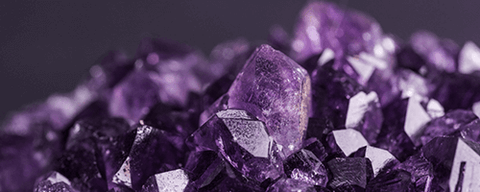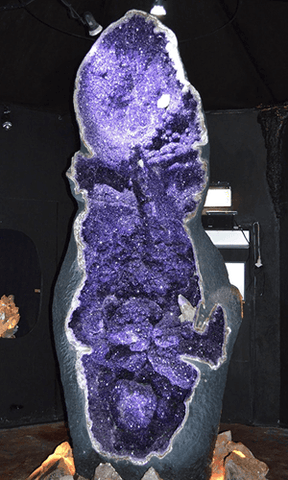
An alluring deep purple, the amethyst is a variety of quartz known for its exquisite colour, and equally rich history. It was named by the ancient Greeks, from the word “amethustos” meaning “not intoxicated”, because they believed that the stone prevented its owner from intoxication, or drunkenness.
Amethyst is a beautiful, affordable and highly durable semiprecious stone, widely viewed as the most valued variety of quartz today and associated with February birthdays and 6th and 17th wedding anniversaries.
Characteristics
Amethyst occurs naturally in primary hues from a light pinkish violet to a deep purple. Its violet colour is due to irradiation, impurities of iron, other metals and trace elements.
Purple, ametrine, pink, mossy, cape and prasiolite are six of the most well-known types of amethyst. Unlike other stones, amethyst's value is based on its colour rather than a carat weight, and the most valuable amethyst beads are those that are dark purple with a reddish tint.
Theworld's largest amethyst geode, named “The Empress of Uruguay”, is the largest amethyst Geode in the world. Originally discovered in the Artigas region in northern Uruguay, the geode was transported to the Crystal Caves Museum in Australia in 2007. Standing a staggering 3.27 meters tall, the geode weighs 2.5 tonnes. Each of the thousands of perfect crystals was formed inside the geode exactly as you see them now, 130 million years ago. An incredible sight to behold!

This dazzling stone has a Mohs rating of 7, so as well as being beautiful, is durable enough for everyday wear, and use in rings, earrings, necklaces, bracelets and any other type of jewellery.
Meaning and history
Amethyst is viewed by many as natures equaliser, believed to bring balance and peace to the wearer, by radiating positive energy. It is thought to have healing properties that reduce stress and anxiety, soothe irritability, dispel anger and rage, calm fear and alleviate sadness.
Also surrounded by ancient myth, the Greeks believed that amethyst was rock crystal dyed purple by the tears of Dionysus, the god of wine and revelry. They believed you could drink all night and remain sober if you had an amethyst in your mouth or on your person.
The colour purple has long been associated with luxury, wealth and status. In the Middle Ages, amethyst was considered a symbol of royalty and was used to adorn English regalia and crown jewels. Kings and Queens alike have admired the deep purple hue since the days of Alexander the Great. Catherine the Great (Empress Catherine II of Russia, 1729–1796) had a passion for amethyst jewellery and owned an impressive collection. Wallis, Duchess of Windsor (1896–1986), was also a lover of this regal stone, seen wearing a lavish Cartier-designed amethyst necklace to a gala in Versailles in 1953. The necklace consisted of 28 individual amethyst crystals set upon a base of 24-karat gold, surrounded with turquoise beads, it was acquired by the Duke of Windsor and gifted to his wife the Duchess in 1947.
Fine amethysts, and the colour purple, also have associations with religion and spirituality in general. The Tibetans consider amethyst sacred to the Buddha and make prayer beads from it. While in Christianity, the gem’s purple colours have been used to represent purity of spirit, and its purplish and reddish hues represent purification and the relief from suffering.
Source
Amethyst was included in the cardinal, or most valuable, gemstones (along with diamond, sapphire, ruby and emerald) until the 19th Century, when it was discovered in abundance in Brazil, where it still occurs in large geodes within volcanic rocks.
These enormous deposits, along with others in Africa, now provide enough material to keep amethyst’s price affordable, and have caused its value to drop significantly. As well as these rich sources, amethyst can also be found in South Korea, Austria, Russia, India, Africa, Canada and the United States.
Amethyst comes from many different mining sources, some of which produce distinct colour varieties. Amethyst from Uruguay has a deep purplish-blue colour, as does Amethyst from Arizona, whereas Amethyst from Russia, colloquially known as "Siberian Amethyst", is very deeply coloured with reddish and bluish tints, originating from deposits that have since been exhausted and which therefore make it more valuable.
Our jewellery
So, whether you are buying a beautiful gift for someone born in February, a special something to mark your 6th or 17th wedding anniversary or adding a favourite piece to your own jewellery collection, we have something very special just waiting for you at Allum and Sidaway.
We have a stunning range of amethyst jewellery, and we look forward to showing you our exquisite collections of gemstones set into earrings, rings, pendants, bracelets, necklaces and brooches, with something beautiful to suit every taste and budget.
We are experts in the jewellery business and can promise you a luxurious shopping experience from the moment you step into one of our stores, until the moment you leave.
Our highly experienced and dedicated team are waiting to welcome you.
